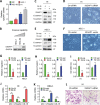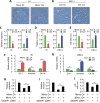Reactivation of epigenetically silenced miR-124 reverses the epithelial-to-mesenchymal transition and inhibits invasion in endometrial cancer cells via the direct repression of IQGAP1 expression
- PMID: 26934121
- PMCID: PMC4991452
- DOI: 10.18632/oncotarget.7754
Reactivation of epigenetically silenced miR-124 reverses the epithelial-to-mesenchymal transition and inhibits invasion in endometrial cancer cells via the direct repression of IQGAP1 expression
Abstract
Overexpression of IQGAP1 and microRNA (miRNA) dysregulation are frequent in human tumors, but little is known about the role of IQGAP1 and its relationship to miRNA in endometrial carcinogenesis. We demonstrate that IQGAP1 activates the epithelial-mesenchymal transition (EMT) program and that miR-124 directly represses IQGAP1 expression in endometrial cancer (EC) cells. The overexpression of IQGAP1 stimulates EMT features and enhances migration, invasion and proliferation of EC cells, whereas knocking down IQGAP1 expression reverses EMT and inhibits these malignant properties. Using miRNA microarray profiling, we identified 29 miRNAs (let-7b, let-7f, miR-10b, miR-15b, miR-23a, miR-24, miR-25, miR-27a, miR-29b, miR-30a-5p, miR-34a, miR-124, miR-127, miR-130b, miR-148a, miR-155, miR-191*, miR-194, miR-224, miR-362, miR-409-3p, miR-422b, miR-424, miR-453, miR-497, miR-518d, miR-518f*, miR-526a and miR-656) that are significantly down-regulated in an in vitro-selected highly invasive derivative cell line (HEC-50-HI) relative to the parental HEC-50 cells. We further identified miR-124 as a direct regulator of IQGAP1 in EC cells. Enforced expression of miR-124 suppresses EC cell invasion and proliferation. The expression of IQGAP1 mRNA was significantly elevated in EC tissues, while the expression of miR-124 was decreased. The downregulation of miR-124 correlates with a poor survival outcome for patients with EC. Treating EC cells with the demethylating agent 5-aza-2'-deoxycytidine increased miR-124 expression and down-regulated IQGAP1 levels. Our data suggest that IQGAP1 promotes EMT, migration and invasion of EC cells. MiR-124, a novel tumor suppressor miRNA that is epigenetically silenced in EC, can reverse EMT and the invasive properties, by attenuating the expression of the IQGAP1 oncogene.
Keywords: DNA methyltransferase inhibitor; IQGAP1; endometrial cancer cell invasion; epigenetics; miR-124.
Conflict of interest statement
The authors declare no conflicts of interest.
Figures





References
-
- Mateer SC, McDaniel AE, Nicolas V, Habermacher GM, Lin MJ, Cromer DA, King ME, Bloom GS. The mechanism for regulation of the F-actin binding activity of IQGAP1 by calcium/calmodulin. J Biol Chem. 2002;277:12324–12333. - PubMed
MeSH terms
Substances
LinkOut - more resources
Full Text Sources
Other Literature Sources
Research Materials
Miscellaneous

